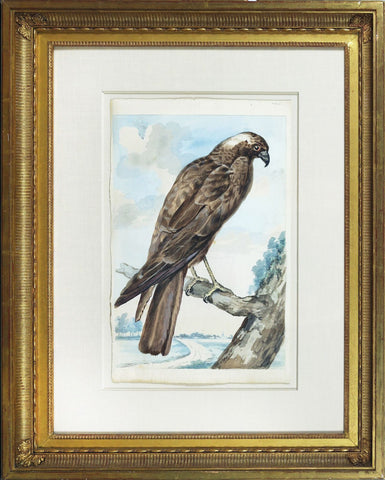George Edwards (British, 1694-1773), Untitled
George Edwards (British, 1694-1773)
Snow Bunting, Winter plumage female.
Watercolor, pencil and gum arabic on paper
Signed 'G. Edwards 1752' below the tree stump
Paper size: 10 1/4 x 8 1/4"
Frame size: 15 x 13"
As a young man, George Edwards found himself in the company of the most influential natural historians, collectors and artists of the 18th-century. Among Ehis first patrons was Sir Hans Sloane, he was taught to etch by the celebrated Mark Catesby (in 1754 he would publish the second edition of Catesby's "Natural History..."), he worked with the Bartrams of Philadelphia and Linnaeus in Sweden.
Edwards' A Natural History of Uncommon Birds - Gleanings of Natural History was one of the most important of all eighteenth-century natural history works, "at its date of issue, the "Natural History" and "Gleanings" was one of the most important of all bird books, both as a fine bird book and as a work of ornithology. It is still high on each list" (Fine Bird Books). The first volume of "A Natural History of Uncommon Birds" was published to great acclaim in 1743, and gained him nomination for fellowship of the Royal Society although he withdrew his candidacy.
Second and third volumes followed in 1747 and 1750 which won him the coveted Copley medal of the Royal Society. The last volume appeared in 1751 at which time he stated that age and infirmity precluded further work. However in 1758 he published the first volume of his "Gleanings of Natural History", the second in 1760, after which he sold his entire portfolio to the Marquess of Bute, "...resigned as bedell to the College of Physicians, and retired to a house in Plaistow. From there he still visited the college and the Royal Society and, stimulated by his drawings of South American birds captured from the French by Earl Ferrers, published a last volume of "Gleanings..." in 1764.
Shortly after he retired in 1769 he sold "to Mr. James Robson, Bookseller all remaining copies of my "Natural History" coloured under my immediate inspection, together with all my copper-plates, letterpress, and every article in my possession relative to it. and that my labours may be handed down to posterity with integrity, truth and exactness, I have delivered into his hands a complete set of plates, highly coloured by myself, as a standard to those Artists who may be employed in colouring them for the future" (George Edwards, declaration quoted in Robson's Some Memoirs, of George Edwards, dated May 1st, 1769). Robson continued to issue sets, again with various changes, and a final edition appeared in 1802-1806, published by W. Gardiner and Messrs. Robinson.
We Also Recommend








